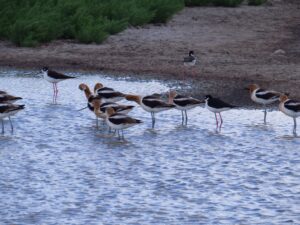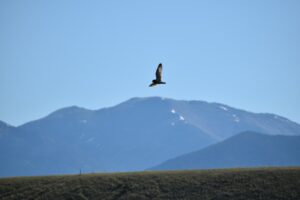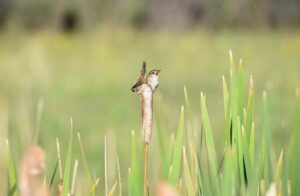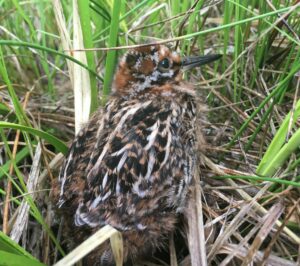How Biologists and Bird Watchers teamed up to document why stream restoration is about more than just fish

Recent news that North America’s bird populations have declined by some 3 million birds is a stark reminder that we must focus our attention on the continent’s most critical bird habitats. Riparian wetlands comprise less than 3 percent of the entire Western United States, yet support almost 90 percent of bird species during portions of their life cycle. In Montana, at least 134 bird species nest exclusively in riparian wetlands found along the banks of streams and rivers. Most of these riparian and wetland habitats occur on private lands. An ambitious restoration project on a small headwater stream in Montana has restored one of the state’s largest spring-fed wetland complexes and serves as a national showcase for the benefits of private lands stream restoration for threatened bird populations.

American Avocets and Black-necked Stilts seen by Bo Crees during a 2020 survey.
O’Dell Creek emerges from a series of springs at its headwaters and meanders north to the Madison River, a blue-ribbon trout fishery in southwestern Montana. Through the efforts of Jeff Laszlo and his family, fifth generation owners of the Granger Ranch just outside Ennis, miles of drainage ditches have been converted back to the creek’s original channel. The restoration plan was developed in collaboration with engineers from River Design Group and a host of federal and state agencies and non-profit groups. So far, their efforts have created more than 15 miles of winding stream channel and nearly a thousand acres of emergent, open water and scrub-shrub wetlands. Lazlo believes “ranching and conservation don’t need to be in opposition to one another. They can fit well together, with one benefitting the other.” His vision has received national recognition. Last year, The Laszlo family received the Environmental Law Institute’s National Wetlands Award for Landowner Stewardship.

Shorteared Owl seen by Amy Seaman during a 2018 O’Dell Creek survey.
Many stream restoration projects focus exclusively on the in-stream benefits to fish and water quality. What sets the O’Dell Creek project apart is the commitment to scientifically monitor ecosystem benefits outside the stream channel and to do so over the long haul. Biologists at the University of Montana Bird Ecology Lab (UMBEL) are working with Montana Audubon and the local Sacajawea Audubon chapter to study the recovery of the O’Dell Creek’s bird community. Since the restoration began in 2005, UMBEL biologists have visited O’Dell Creek during the breeding season to record all bird species seen or heard from established locations in the project area. They also broadcast recordings of secretive marsh birds to elicit responses from hard to detect species like American Bittern and Virginia Rail. In the fall, Audubon members count birds congregating in the area, along with other important migratory habitats in the Madison Valley.
The results of these bird surveys offer a rare glimpse into the long-term benefits of restoration for birds. Monitoring is usually done for a few years after a project is completed, if at all. But habitat recovery takes time. “It can be hard to see the level of reconstruction required to re-grade channels and restore bank structures, but once the hydrology is reset, riparian vegetation can recover rapidly — and with it, the bird community,” says UMBEL biologist, Anna Noson.

Singing Marsh Wren seen by Amy Seaman during a 2018 O’Dell Creek Survey.
Some of the benefits were immediate—there were 46 more bird species in the area just five years after restoration began. Many of the birds that showed up first were waterfowl, attracted to newly created open water wetlands. Sedges and other wetland plants grew quickly with increased soil saturation. This led to an explosion of birds from diverse groups, including gulls, herons, and rails. In contrast, most songbirds were not as quick to begin nesting in the area. Red-winged Blackbird were the only songbird species that increased in the first three years, and some, like the Marsh Wren, took eight years to begin using the restored wetlands. Songbirds that nest in riparian shrubs, like Yellow Warblers, are just now showing up in larger numbers.
Nearly fifteen years after restoration began, biologists and birdwatchers have documented 121 bird species on O’Dell Creek during the breeding season. In the fall, Audubon volunteers find large groups of waterfowl and Sandhill Cranes— evidence that the area now provides an important staging area for migrating birds. These results show that the success or failure of a restoration effort is measured on the scale of decades, not years.

Wilsons Snipe Fledgling seen by Amy Seaman during a 2018 O’Dell creek Survey.
Montana Audubon’s Amy Seaman is struck by the diversity she finds now on O’Dell Creek. “In places where the ground sags and bubbles under your steps, I keep an eye out for a Wilson’s Snipe. In other spots the reeds are so high you feel like you vanish, but you get eye to eye with Marsh Wrens and Trumpeter Swans. In the driest areas you may get ambushed by a Long-billed Curlew.” The fly-fishing community will be glad to know that trout numbers are up too. Narrower channel dimensions, improved bank shade, and increased channel complexity benefits the entire river system, sending cold water and trout into the mainstem Madison River.
This project would not have been possible without generous support from private industry and non-governmental conservation organizations. Northwestern Energy contributed more than $2 million to the effort as part of their commitment to wildlife habitat improvement on the Madison River. Documenting the benefit of these large-scale projects on private lands is important for justifying the expense and encouraging future restoration. “We are finding that investing in restoration of stream and wetlands can have a huge return for breeding birds, as well as fish and water quality,” says Noson.
The success of restoration on Granger Ranch has encouraged neighbors to join in. And so the work continues one phase at a time downstream toward O’Dell Creek’s confluence with the Madison River. These forward-thinking landowners on O’Dell Creek are leaving a vital legacy behind for future generations of nature lovers, birdwatchers, and fly-fishing enthusiasts.
Follow the UM Bird Ecology Lab on Facebook and Instagram to learn more about birds and ongoing research conducted at the University of Montana. If you have any questions about the O’Dell Creek project, please contact Anna Noson.


